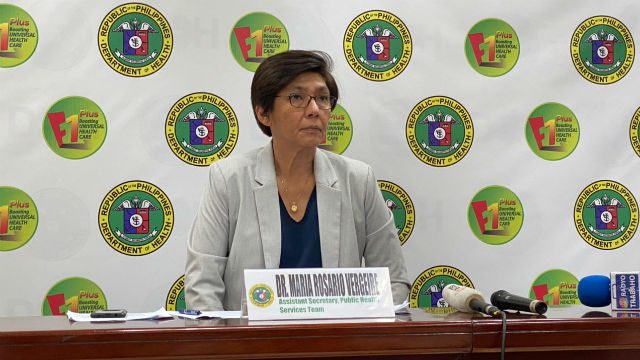SUMMARY
This is AI generated summarization, which may have errors. For context, always refer to the full article.

MANILA, Philippines – After over 20 deaths were added to the Philippines’ coronavirus death toll on Saturday, June 13 – adding to the 16 new deaths reported on Friday, June 12 – the Department of Health (DOH) explained that these deaths did not occur on those days alone, and were due to late reporting.
The DOH also said that as of mid-June, the country’s COVID-19 case fatality rate has been showing a “downward trend.”
In a briefing on Sunday afternoon, June 14, Health Undersecretary Maria Rosario Vergeire explained that of the 22 deaths reported on Saturday, only 4 died within the month of June. These deaths happened on June 3, June 4, June 6, and June 9, said Vergeire.
The other 18 died in previous months, but were included in the death toll only on June 13 because these reports were submitted to the DOH’s Epidemiology Bureau from local government units (LGUs) “only recently.” Vergeire said deaths undergo a validation process before being included in the counts.
In a separate statement, the DOH reiterated the spike was due to “a delay in the submission of validated mortality cases from the LGUs to the DOH’s Epidemiology Bureau.”
These explanations are similar to the DOH’s distinction between “fresh” and “late” cases for the total COVID-19 cases in the country. “Fresh” cases are those whose test results were released within the last 3 days, while the “late” cases are those with test results released after 4 days or more. (READ: DOH explains spike in COVID-19 cases since easing of lockdown)
During the briefing, Vergeire talked to epidemiologist Dr John Wong, who explained that the recent increase in reported deaths “has been due to late reports.” He also noted that the median number of deaths remains “low at 9 per day.”
He presented a graph plotting the deaths by their actual date of death. “It peaked around maybe 1st week of April, and since then has continued going down,” he said.
Wong is a member of the sub-technical working group on data analytics of the government’s Inter-Agency Task Force for the Management of Emerging Infectious Diseases (IATF). He is also a professor at the Ateneo School of Medicine and Public Health.
‘Downward trend’
Vergeire added that the country’s case fatality rate – or the percentage of deaths in the total number of cases – has gone down to 4.24% as of June 13, from 5.52% on May 31.
“Although we are above the ASEAN average, we are below the global average, and we’re also better than Indonesia,” Wong noted.
Wong also pointed out that the delays in the reporting of COVID-19 deaths have decreased over time. “From a high of about a 22-day delay from date of death to [date of] reporting, right now it’s only about a 7-day delay.”
Data management problems were among the issues raised by Dr Tony Leachon in a tweet about the IATF on Saturday, days before the agency was set to recommend adjustments to the community quarantines to President Rodrigo Duterte. Leachon is a special adviser to National Task Force (NTF) COVID-19.
“Forgive me, I think the lead agency has lost focus in everything. Risk communication, priorities, data management, and execution of all plans,” said Leachon.
It’s a sad day as we anticipate the IATF recommendations on Monday to PRRD. Forgive me, I think the lead agency has lost focus in everything. Risk communication , priorities , data management , and execution of all plans.
— Tony Leachon MD (@DrTonyLeachon) June 13, 2020
That’s all it is.#FlattenTheCurve
In another tweet on Sunday, Leachon commended the IATF and the NTF for “working hard.” However, he said he is “frustrated with the lack of sense of urgency of the DOH leadership in data management.”
Asked about the DOH’s explanations on Sunday on recent COVID-19 deaths, Leachon told Rappler, “No comment.” – Rappler.com
Add a comment
How does this make you feel?
There are no comments yet. Add your comment to start the conversation.